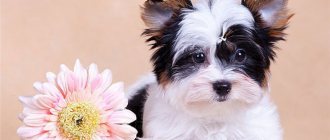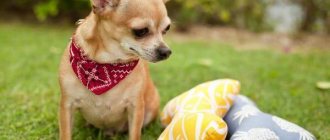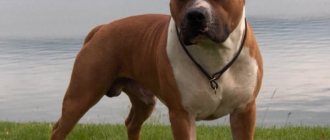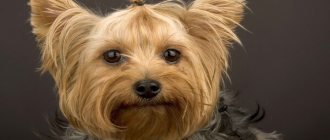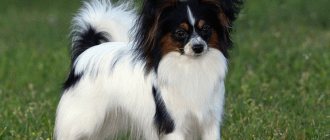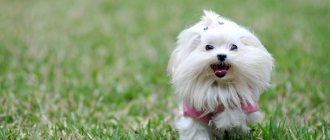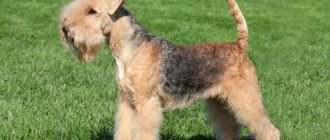Video
* We invite you to watch a video about the Boston Terrier . In fact, in front of you is a playlist in which you can select and watch any of 20 videos about a given dog breed by simply clicking on the button in the upper right corner of the window. In addition, the material contains quite a lot of photos. By looking at them you can find out what a Boston Terrier looks like.
In this article:
|
Rate the material!
[Total votes: 3 Average: 3.7]
The Boston Terrier has become popular since its creation, just over a century ago. They were originally bred to fight with other dogs, but today they have become gentle and affectionate companions. Their tuxedo-like coloring gave them the nickname "American Gentleman." And although the popularity of the breed declined at the beginning of the 21st century, breeders still hope for a return of interest in these amazing dogs.
History of the origin of Boston Terriers
In the second half of the 19th century, in the New England area, a breeder crossed an English Bulldog with a White English Terrier. The result of this crossbreeding was a very tall dog that weighed 14.5 kg with dark stripes and white spots. They called him "Hooper's Judge". In 1865 it was purchased by one William O'Brien of Boston, Massachusetts (USA), who later sold it to Robert S. Hooper, also of Boston.
This dog was subsequently crossed with a female named "Gyp", owned by Mr. Burnett of Deerforth Farms, Massachusetts. She was white and had short legs, as well as a short muzzle and a square head. Although the appearance was not as expected, Mr. Hooper was pleased with the result. The offspring resulting from this crossing was the beginning of the breed.
It took many decades and many generations of inbreeding, outcrossing and crossbreeding to produce the breed we know today as the Boston Terrier. It is also believed that the French Bulldog was one of the ancestors of this breed.
Fun Fact: Since this breed didn't have a name, owners experimented with different names, including Roundhead, but none of them stuck. Then H. Lacy, a judge and journalist, suggested in a local newspaper article that since this small breed was native to the historic city of Boston, why couldn't it be called a Boston Terrier? That's what we decided.
In 1891, more than 40 owners founded the Boston Terrier Club of America, which detailed breed standards. After the dog was accepted into the American Kennel Club in 1893, its popularity increased. By 1908, the Boston Terrier had become popular in Canada. In the early 1930s, enthusiastic fans brought the Boston Terrier to Great Britain.
As interest in him increased, Arthur Craven asked to actively breed Boston Terriers in order to write a book with illustrations of breeders of this breed. Craven had already written books on other breeds and, after careful consideration, wrote The Boston Terrier as I Know Him.
History of the Boston Terrier breed
Boston Terrier
The history of the breed began at the end of the 19th century, in America. In 1870, Boston resident Robert Hooper bought an unusual dog from his friend William O'Brien. According to the seller himself, the stocky, strong male was a cross between an English terrier and an English bulldog, which provoked Hooper to make a spontaneous purchase. Without hesitation for a long time, the Bostonian christened his ward Judge and took him to mating with a bitch named Jip, who belonged to Edward Burnett. After the allotted time, Jip gave birth to a cute male dog, named Wells Ef, and an elegant “girl” - Tobin Keith. When the puppies grew up, they were bred first with each other, and then with their parents, thereby laying the foundation for the gene pool of the future breed.
Over the next decades, Massachusetts breeders, including the same Robert Hooper, carried out targeted work to improve the exterior performance of dogs. For example, the first generations of animals were infused with the blood of the Old English White Terrier several times, which helped make their figures less brutal. Gradually, another distinctive feature of the descendants of Judge began to emerge more clearly - the rounded shape of the skull, and therefore the dogs began to be called round-headed bullies. Later the name was transformed into American Bullies, and then into American Bull Terriers - it was under this phrase that the first “Bostons” appeared at exhibitions. This did not last long, as the breeders of the then popular English bull terriers rebelled against the name. Angry owners demanded the immediate renaming of the Massachusetts Mixed Breeds to avoid confusion in defining the breeds. So Judge's descendants became Boston Terriers.
The first club of fans of the breed was formed in its homeland, Boston, in 1889. Two years later, the organization was renamed the American Boston Terrier Club, and a couple of years later it joined the AKC. As for entering animals into stud books, this was first done in 1893, after which Boston Terriers became the most sought-after pets among middle-class Americans. However, already during the Great Depression, the popularity of the breed began to decline. The situation was aggravated by the Second World War, after which dogs began to be imported to the United States from Europe. Nevertheless, the Bostons were never on the verge of extinction.
Boston Terrier - description of the breed
The Boston Terrier is a small, compact dog with square features. It has a flattened muzzle, similar to a bulldog, but without the folded skin. The length of the muzzle is about one third of the total length of the skull. The ears are small and straight. The wide black nose is divided by voluminous nostrils.
The eyes are large, round and dark, set at right angles to the skull, well separated from each other. The tail is short, as are the limbs, angular and strong. This is a robust dog and its limbs should be in proportion to the size of the animal's body.
In competitions, dogs must meet certain standards. Although these standards sometimes differ, most are common to all.
These dogs are divided into three categories depending on the weight of the animal:
- Less than 6.8 kg;
- From 6.8 to 8.6 kg;
- From 9 and 11.35 kg.
To receive a good score, a sample must meet a number of specified physical characteristics.
Among which:
- Scull. Should be square, flat on top. Have flattened cheeks and severe frontonasal depression;
- Face. The eyes are dark in color, without the slightest blue sign. The muzzle should not have wrinkles and should be wider than long. It should also be parallel to the skull from the frontonasal cavity to the tip of the nose. The jaw is wide and square, the lips completely cover the mouth so that the teeth are not visible;
- Body. The back is short. The body appears square, horizontal and straight, with a slight curve towards the tail. Shoulders tilted and pulled back. The animal's limbs should have straight elbows and knees, as well as small and round feet with short nails. The coat is short, smooth, shiny and strong, without hair loss.
Boston Terrier breed standard
Boston Terrier Puppy
The classic Boston Terrier is a bulldog-like flattened muzzle and splayed front paws, plus a muscular body and rapid movements of the terrier. Solid, but proportionally built, this medium-sized “American” is completely devoid of the stockiness and clumsiness of a bulldog, and, unlike its English ancestor, it has no folds on its muzzle. Sexual dimorphism in Boston Terriers is insignificant, so the only thing that distinguishes “girls” from “boys” is a more elegant bone structure and general sophistication of appearance. In general, the appearance of the Boston Terrier is the image of a stylish “dandy”, the formation of which is facilitated by the proud posture of the dog and its unique color, reminiscent of an elegant tailcoat with a snow-white “shirt front” on the chest.
Head
Boston Terriers are typical brachycephalics with a square, flat skull between the ears and an ultra-short, massive muzzle. Representatives of this breed have clearly defined eyebrows and feet, and flat cheekbones.
Jaws and teeth
The jaws of Boston Terriers are square, massive, closed in a straight bite (let's say an undershot). The teeth are medium-sized, with incisors located along the same line.
Nose
The lobe is stretched wide, with a well-drawn midline between the nostrils.
Eyes
The correct Boston Terrier has wide-set, rounded, dark eyes.
Ears
The dog's ears are erect, wide and high set. A cropped ear shape is also allowed by the standard.
Neck
The Boston Terrier's neck is high-set, slightly arched, gently merging into the withers.
Boston Terrier muzzle
Frame
The dog's body is square, but not stretched. The Boston's back line is flat, with a short loin and sloping croup. The chest is wide and quite deep.
Boston Terrier from the back
Limbs
Distinctive features of the front legs of the Boston Terrier are a wide set, oblique shoulder blades, responsible for the grace of the animal in movement, and short, strong pasterns. The dog's hind legs are level, with sloping fleshy thighs, distinct angulations and short and straight metatarsals. The Boston Terrier's paws are tightly knit, with arched toes ending in short, massive claws. Representatives of this breed also have dewclaws, which are best removed in a timely manner. The animal's movements are straightforward, rhythmic, without stiffness.
Tail
The short, thin tails of Boston Terriers are carried straight or curled into a corkscrew and do not rise above the line of the back. The optimal tail length is ¼ of the distance from the croup to the hock.
Wool
The short, glossy coat adheres well to the skin and is practically devoid of undercoat.
Color
The traditional coat colors of Boston Terriers are dark brown (seal), black and brindle, all of which should be diluted with white spots. The standard approves white markings: a wide stripe between the eyes, the outline of the muzzle, a spot that occupies the entire chest. It is highly desirable that the animal have white forelimbs, “collar” and hind legs (not higher than the level of the hocks).
Defects and disqualifying defects
Brown Boston Terrier (liver)
Ideal in exterior terms, “Bostons” are an exceptional phenomenon rather than a widespread one. Usually animals have a couple of defects of varying severity that do not affect health, but prevent the dog from receiving a champion diploma at exhibitions. These are: eyes with visible whites, a skewed lower jaw, large/disproportionately small ears, a tail carried vertically, a back with a sag or a hunchback. Animals with open paws, straightened hocks, waddling and ambling cannot count on excellent marks either.
Disqualifying faults:
- complete absence of white marks on the coat;
- Blue eyes;
- gray and liver colors;
- docked tails;
- light lobes.
Popular colors of Boston Terriers
Bostons have distinctive white markings.
They are arranged proportionally:
- Black with white markings, dark eyes, black nose;
- Seal (wet seal color, a very dark brown that looks black except in bright sun);
- Tiger is a combination of these three colors.
Any other color is considered incorrect, as the Boston is usually obtained by crossing with other breeds, and the dog loses its characteristic "tuxedo" appearance. Boston Terriers are not one color. Beware of breeders who try to sell you a one-of-a-kind dog because of its “rare” color. Failure to comply with the breed standard indicates a low-quality breeder.
According to the American Kennel Club, the ideal Boston Terrier should be white in certain areas. The rim around the neck, the gap between the eyes, the rim around the muzzle, and the shirt-front covering the chest should be white. Also, streaks of white should be found halfway up the front legs and to the hocks on the hind legs. Symmetrical markings are preferred to show compliance.
Interesting Fact: A dog with a predominant white body or head color must have a noticeable amount of merit that counteracts this problem in order to be able to compete.
The Boston Terrier is easy to care for. You can bathe them occasionally, if necessary, or simply wipe them with a damp cloth. Because the breed's eyes are large and prominent, you should wash your dog's face every day and examine the eyes for signs of redness or irritation.
Breed standard
The Boston Terrier breed has the following standards:
1. The dog’s head is square-shaped, its forehead is wide.
2. The lips are plump, fleshy, covering the lower jaw, not too wet.
3. The dog’s teeth are quite small and not too powerful, since this breed is not a fighting breed. The bite is even. The mouth is large and deep, but the grip is not strong.
4. The nose is large, the nostrils stand out clearly, they are symmetrical with each other, there is an even groove at their separation from each other.
5. Dogs' eyes are quite large and expressive, their gaze is intelligent, kind and loyal. Ideally, a dog's eyes should be dark in color, the darker the better.
6. The ears are set wide apart; the dog can raise them if desired. The shape of the ears is slightly rounded, in some cases they are cropped to a sharp triangular shape.
7. The dog’s body, like its head, is also slightly angular and resembles a square. The neck is quite graceful and curved, smoothly blending into the withers. The back is flat, the chest is wide.
Boston Terrier sadly waiting for his owner
8. Boston dogs have long limbs, but they are located in proportion to the body. The hind legs are curved. The foot itself is neat and rather small, the toes are slightly curved.
9. The coat is quite short, lies close to the body, and shimmers a little in the light.
10. The dog’s tail is set low, not long, and becomes sharper towards the end.
Attention! Dog experts say that if a dog’s tail is set too high or has a curled shape, then this is considered a breed fault. Tail docking does not solve the problem.
Character and habits of Boston Terriers
The Boston is a gentle breed that has a strong, happy and friendly nature with a cheerful disposition. The Boston Terrier is usually eager to please its owner and is easy to train. Dogs seek to protect their owner, which results in aggressive and territorial behavior towards other pets and strangers.
The breed requires a minimal amount of grooming. Male dogs try to demonstrate their terrier heritage with a bit of aplomb when they feel their territory is being encroached upon by a strange dog.
Interesting fact: Boston was bred to participate in battles and also to hunt rats in clothing factories, but today it is a sweet and good-natured creature whose habits would never tell. The Little American Gentleman, as he was called in the 19th century, is a friend, not a fighter.
Boston Terriers are known for their intelligence, which can sometimes be a bit too much. Their lively, affectionate nature makes them extremely attractive to keep, although sometimes their stubborn nature and bursts of hyperactivity can cause a lot of trouble for owners. However, any fear about the Boston Terrier's behavior soon disappears as they look at their owner with huge round eyes that say, “I love you.”
Boston Terriers, despite their small size, are strong and muscular. They have a slightly curved, proud neckline, a wide chest and a strong, square appearance. The Boston Terrier's small size and lively, affectionate nature make it an excellent choice for a family companion. They love children and their antics amuse people of all ages. It is a good companion for the elderly.
Both females and males are calm and only bark when necessary, although early training in this regard is necessary. Their intelligent behavior towards barking makes them an excellent choice for apartment dwellers. The Boston Terrier enjoys being around people. They will get along well with children, the elderly, other dogs and pets if properly socialized.
Positive qualities of the Boston Terrier
- The Boston Terrier is a very smart and efficient . He does not need to repeat commands several times; he understands not only the words, but also the intonations of the owners.
- This dog behaves very tactfully , understanding when there is time for games and when the owners have no time for it. True, to achieve this, you will need to make an effort, explaining to the puppy when it is possible to indulge, and when it should wait in its rightful place.
- The Boston Terrier trusts its owner unconditionally , will never betray him, and will be there in times of danger.
- In the family, representatives of the breed find a common language with everyone . They are friends with children and willingly join in their games.
- They generally get along well with different animals , but can become jealous of their owners and start a fight.
- The Boston Terrier is comfortable almost everywhere . This could be a small apartment, a house, or an adjacent area. The main thing is that the pet has its own small cozy space where it can relax and sleep peacefully.
- have never owned a dog before . However, you will need to devote enough time to training the puppy, give commands in a calm, quiet voice, and then in the future there will be practically no problems with the pet.
- These dogs bark very little , and only when they want to warn their owners that someone is approaching them.
- The Boston Terrier is not adapted to great physical activity , which means the owner will not have to devote a lot of time to walks or turn them into active and fun-filled hikes.
- This terrier sheds like other dogs, but in smaller quantities , so lost hair can be easily and quickly removed.
Interesting facts about Boston Terriers
The breed, named after the city, will make an excellent city pet. Boston Terriers are robust but portable, people-oriented dogs, always ready for a quick walk to the park or outdoor café. A flamboyant dog with a naturally comical streak, the Boston Dapper is a constant source of smiles.
Interesting facts about Boston Terriers:
- Dogs with short noses are not able to cool the air entering their lungs like breeds with long noses. Therefore, they are more susceptible to heat stroke. And because of their short fur, they have difficulty withstanding very cold weather. Even in temperate climates, Boston Terriers need to be kept indoors;
- Since the breed may have breathing problems, it is best not to use a collar and use a harness;
- The Boston Terrier is prone to developing corneal ulcers due to its large, protruding eyes. You need to be careful with your eyes when he plays or goes for a walk;
- Because of their shortened nose, Boston Terriers often snort, drool, and snore (sometimes loudly);
- Boston Terriers are generally quiet, gentle dogs that are not prone to aggression. Males can be pompous towards other dogs that invade their territory;
- Boston Terriers can be gluttonous, so you need to monitor their condition and weight gain;
- They can be quite stubborn. Persistence and consistency in teaching methods will be a definite plus. Dogs are sensitive to the tone of your voice. Training should be motivating and discreet;
- To get a healthy dog, never buy a puppy from an irresponsible breeder. Look for a reputable seller who tests the breeding quality of the dogs to make sure they do not have genetic diseases that can be passed on to the puppies.
Boston Terrier: owner reviews
Dog owners note the following positive traits in these dogs:
- cheerfulness - these dogs charge everyone around with energy;
- devotion;
- subtle mental organization - this dog senses the mood of the owner and always responds vividly to praise;
- intelligence and aristocratic manners;
- attractive appearance;
- friendly character.
The dog will be happy to keep you company: in games, food or sleep. Children love them very much and dogs reciprocate. The Boston Terrier dog will become the favorite of all family members. It is important not to let her sit on your neck.
To get a real aristocrat, you need to raise a puppy from childhood. The dog needs to be occupied, otherwise it will get bored and start acting out. And these pets are very sensitive to punishment.
The only disadvantages include poor health. According to owners, these dogs get sick too often.
Pros and cons of Boston Terriers
Boston Terriers have a lot of personality. Some are energetic and often clownery, while others are calm and dignified “gentlemen.” There are characters who are stubborn and rebellious, while others are sweet and gentle companions. But overall, the Boston Terrier is an absolutely adorable little dog.
Games and chasing balls are (usually) his two passions. Seeking companionship is another of his passions because the Boston Terrier always wants to be with his family. His large expressive eyes, attentively upturned head, snorting and sniffling sounds reveal parental feelings in many people.
Some Boston Terriers are extremely sensitive to their owner's moods. They are reliable watchmen who will let you know when someone is hiding behind the door. This breed is a good choice for first-time owners because... has many positive qualities.
If you want a dog that:
- Small but strong - not a fragile dog;
- Has large expressive eyes;
- Has a smooth coat;
- Polite with everyone, including other pets;
- Loves to play games and chase balls;
- A very loyal friend to his owner.
The Boston Terrier may be the right choice for you.
If you don't want to deal with a dog that:
- Snorts, sniffles, wheezes, snores, produces a little drool;
- Has many potential health problems;
- Stubborn.
In this case, the Boston Terrier may not be suitable for you.
Breeding Boston Terriers
Breeding Boston Terriers requires knowledge of the health problems that plague American gentlemen, including birth difficulties, cesarean sections, and the dreaded brachycephalic airway obstruction syndrome.
Breeding Boston Terriers can be considered relatively easy compared to other, much more complex, dog breeds. Mating (copulatory relationship) usually goes smoothly.
Boston Terriers typically have 3 to 5 puppies, and the maximum litter size is a maximum of 7 puppies. Litters of more than 7 puppies are considered very rare. Keep in mind that healthier dogs will have more puppies. There is one way to increase the number of puppies - to mate more than once per mating. However, if mating is done more than once, the male's sperm count will decrease.
Due to their head size and small pelvis, Boston Terriers are at increased risk of caesarean section. With that said, quite a few bitches have a normal vaginal birth. To reduce the chance of a C-section, buy high-quality dog food that contains plenty of calcium. When dogs are calcium deficient, labor becomes longer and more painful, increasing the likelihood of a caesarean section.
Fun Fact: The Boston Terrier is ranked #1 among the dog breeds that are at greatest risk for surgery.
When your dog is pregnant, give her a quality puppy food or product for all life stages. Both of these products contain more nutrients than adult dog food. When your dog gives birth, you can add extra calcium, feed it cottage cheese, or give Calsorb gel, which is available in a syringe, for quick absorption.
Boston Terrier Care
For a Boston Terrier to live as long as possible, it must be in excellent health and be joyful and happy throughout its life. It is difficult to overstate the need for proper diet and exercise for this breed.
What you need to do to maintain good health in your pet:
- Monitor your pet as you would a normal baby. Keep doors closed, don't throw things around, block off rooms if necessary. This will save the dog from troubles and allow him to avoid objects that should not fall into his mouth;
- Brush his coat as needed, preferably weekly. Face and tail folds should be kept clean and dry to prevent infection;
- Boston Terriers generally have good teeth and should be kept in perfect condition by brushing twice a week;
- Clean his ears weekly. Don't worry, the dog quickly gets used to this procedure. But if you are not sure whether you have cleaned the ears properly, take your pet to the veterinarian once a month for a better procedure;
- The dog is well suited for living in an apartment, but he is very active and will therefore need a daily walk and regular indoor games;
- This is a sensitive dog and does not cope well with harsh training methods or punishment. Always end your workout on a positive note;
- The Boston Terrier is sensitive to extreme temperatures. Avoid prolonged exposure to severe weather and be very alert for signs of heat stress;
- Follow your dog's diet and do not feed food from the table. Feed her age-appropriate quality food;
- Exercise your Boston Terrier regularly, but do not overdo it.
Any symptom that deviates from the norm can be a sign of a serious illness. It is important to understand when to seek veterinary care. Many diseases cause a combination of symptoms in Bostonians, which together can serve as a clear signal that the pet needs help.
Boston Terrier diet
Despite their small size, Boston Terriers have quite a large appetite, but their susceptibility to allergies can make it difficult to choose the right type of food. Let's figure out what should be avoided? What food should I provide them with? And how often should I feed them?
In general, Boston Terriers do not have dietary preferences that are breed specific. There are several ingredients that you should consider when choosing a product.
- Protein. Dogs are carnivores (as they are still genetically wolves). Because of this, the vast majority of their food must be protein, and they need a lot of it - much more than humans. Almost all dog foods meet this need and use protein as the main source of nutrients.
- Grains. Boston Terriers have sensitive stomachs that react poorly to some low-quality foods that contain grain as a carbohydrate source.
- Dry food. The breed has an unusual tendency to have bad breath, and canned food makes the problem worse.
- Allergies. There are no breed-specific allergies, so watch for symptoms when consuming beef, dairy, chicken, fish, grains, and soy.
If you notice any symptoms of an allergic reaction, then make an appointment with your veterinarian to have your dog checked. The calorie requirements for Boston Terriers are the same for both sexes. On average, an adult dog should consume about 650 calories per day. Athletic dogs are much more active than regular pets, and therefore you should increase your daily caloric intake slightly.
Important fact: The Boston Terrier is susceptible to the so-called “bottomless stomach syndrome.” They are completely unable to self-regulate the amount of food they eat and, if given the opportunity, will eat an entire day's worth of food in one sitting. This means that they are not suitable for automatic feeders.
Every dog is unique and these are just guidelines. The real way to determine if your dog's food intake is adequate is to monitor his weight. If he becomes more plump, then a diet is needed. Excess weight puts enormous stress on the body of a dog the size of a Boston Terrier and can shorten its lifespan and cause joint problems. Adult Boston Terriers should be fed twice a day, and puppies - 3-4 times. You should switch to eating twice a day by the time your puppy is one year old.
Boston Terrier personality
Love
Boston Terrier is a good-natured house clown, making funny faces, fooling around like a child and charging the surrounding space with positive energy. Friendly, restless, ready to give attention to anyone and everyone, he is absolutely devoid of such qualities as aggressiveness and suspicion. So, for example, the Boston Terrier does not care at all who the two-legged creature that appears on the threshold of your apartment actually is - a representative of network marketing or a family friend. This “Massachusetts native” is loyal to any person, as long as he does not violate territorial boundaries or try to use physical violence.
Dogs have peace and understanding with children. Boston Terriers do not try to compete with representatives of the younger generation for their master's attention, preferring to join their company in order to play pranks together. They also do not disrespect the feathered and fluffy pets living with them in the house. Of course, there have been, are and will continue to be attempts to pounce on a cat who has lost his vigilance. But usually, having received a sobering slap with a paw, most dogs calm down and stop purring.
Boston Terriers have a philosophical attitude towards forced loneliness. They do not make a scene and do not destroy the apartment if there is no creature nearby that at least somewhat resembles a person. The main thing is to give your pet a good walk before leaving him alone with his own thoughts. Having gotten rid of the energetic and emotional burden, the Boston will peacefully lie down in your absence, plunging headlong into the world of dog dreams and dreams. Well, for those who are planning systematic absences, it is worth keeping the animal company in the person of a second Boston Terrier: the two “gentlemen” will have more fun while away the hours while waiting for the owner.
Boston Terrier with a child
Unbridled joy
Diseases and health problems
Many diseases and health conditions are genetic, meaning they are associated with the Boston Terrier breed. This does not mean that your dog will have these problems, it just means that he is at greater risk than other dog breeds.
We will describe the most common problems to give an idea of what may happen in the future:
- Cataract. Bostons are prone to developing juvenile and adult cataracts. Juveniles develop in puppies from eight weeks to 12 months. When purchasing a puppy, it is advisable to ask the breeder whether it has passed the juvenile cataract test;
- Cherry eye - believed to be genetic in origin. It occurs more often in dogs under one year of age. Veterinarians try to surgically move the gland to its original location;
- Stifle dislocation (“slip knees”) is a common defect in small dogs. Caused by the patella not being aligned correctly. Causes lameness and abnormal gait. This condition is present at birth, although actual displacement or dislocation occurs much later;
- A heart murmur is a soft or loud, sharp sound in the heart, especially in the part of the mitral valve, where this defect causes blood to flow back into the left atrium. Therefore, the heart is not as efficient in supplying the body with blood;
- Deafness. Boston Terriers often have deafness in one or both ears;
- A brain tumor;
- Allergy. Boston Terriers suffer from a variety of allergies, including contact allergies and various food allergies. If a Boston licks its paws or rubs its face too much, it may have an allergy;
- Megaesophagus. A defect in the structure of the esophagus, causing the dog to regurgitate undigested food;
- Reverse sneezing. The condition can occur at any time in a Boston Terrier's life. Occurs when the dog is agitated, swallows food quickly, or is exposed to pollen in the air.
Origin story
The first representatives of the Boston Terrier breed were introduced by the American sailor Robert Huppert, and this happened in 1865. The sailor had a puppy, Judge, a variety of bull and terrier, which at that time was very popular among the British. In particular, representatives of this breed were constant participants in dog fights.
Judge had a dark brindle coat, a white chest and throat, and cropped ears. In general, it was a rather impressive pet, weighing about 15 kg. By chance, Judge crossed with the female of the sailor's neighbor, Jeepy. As a result, the animals produced offspring of the same type, which were almost completely similar to the father. This characteristic indicates the stable heredity of bull and terriers.
Actually, it was with this offspring that the era of breeding Boston Terrier dogs began. Initially, the descendants of animals crossed with each other, as a result, all the bred pets had round heads. Moreover, this was the reason that at one time representatives of this dog breed were called round-headed Bulies. A little later the name was changed to “American” or “Boston” boules. But this became the reason for the subsequent conflict with the breeders of English bulldogs - by the end of the 19th century, these pets could already boast of a good history.
In 1878, the first Boston puppies were shown at an exhibition, then they were called Round-Headed Bulies. It should be noted that representatives of this dog breed quickly became popular among Americans. The twenties of the last century became the peak of popularity of animals who were called “gentlemen from Boston.” Today, many foreign and domestic breeders are engaged in breeding these pets. Secular women often use representatives of this breed of dogs as companions, carrying them everywhere with them (the author of the video is Ksenia laskova).
In 1896, another exhibition was held, at which the winner was the dog Topsy, who is the great-granddaughter of the English bulldog. As a result of these events, the popularity of this species began to grow; at one time, even the US leadership kept these pets in the White House. Already in the 30s of the last century, at events that took place in the USA, about a third of all participants were Boston Terriers. The most famous representative of the variety is the Dandy Elbos Rudy dog, which was recognized eighteen times as the best animal at exhibitions. In total, these pets were able to defeat about 50 thousand dogs, and Elbos received the title of champion 50 times.
In the same year, when the Boston Terrier received official recognition, information about these pets began to be recorded in the stud book. Currently, about thirty thousand dogs are officially registered in the United States alone, and the dog Hector was the first to be described in the stud book. Huppert, having become the founder of this variety of pets, at one time gathered around him several dozen enthusiasts, thanks to whom the breed became so widespread. Men engaged in crossing animals, from time to time adding the blood of other animals to the breed. It should be noted that the main changes in appearance are due to the addition of white terrier blood, which gave the dogs modern features.
At one time, breeders carried out crossbreeding with other dogs brought from Great Britain. Even several records have been preserved that indicate that boxers and pit bulls took part in the selection. Before puppies of this breed were recognized, they bore several intermediate names, indicating a particular time in the formation of the breed. The first official standard was adopted in 1891 (video by Vanilla Carmelatte).
Since the Boston Terrier has become one of the most popular dog breeds in the United States, the port city began to be considered the homeland of the animals. When World War I ended, puppies found their way to European countries and, in the 1920s, to England. It should be noted that many dog breeders do not see a fundamental difference between French bulldog puppies and Boston dogs, so this variety is not so common in Europe. According to experts, these two varieties are completely different in terms of character.
